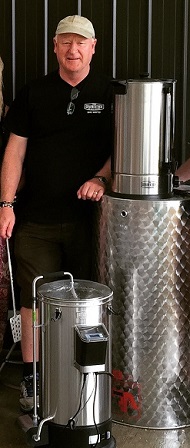Start 14-Day Trial Subscription
*No credit card required

Going With the Grain
When New Zealander Peter Eastwood started his homebrewing business in 1989, most homebrewers used extract kits for their ease of use and ubiquity. Despite swift growth in the local market and expansion to Australia in 1995, Eastwood wanted more. He felt that extract kits, while effective and easy, were missing a key cog in the quest for true craft beer. Thus, the idea for the Grainfather took root.
Eastwood believes The Grainfather is the answer to making true craft beer at home: “People can make good beer with extract kits or with partial grain kits, but if they want to make craft beer they should be loving it and they should be working over it and they should be keeping in touch with it right down to the brewing process.”
The Grainfather started off as an “embryonic idea” of converting the highly industrialized manufacturing process for all-grain brewing into a compact homebrewer’s kit.
According to Eastwood, “the original concept was really just a boiler with a way to mash inside it,” but the idea evolved and he refined the design into what the Grainfather is today: “an advanced kit that pretty much emulates what most commercial batch brewing is about and allows people to do it at home with the same control, or better control, than what a lot of brewers can get.”
The Grainfather is different from other homebrewing kits in that it is literally an all-in-one all-grain brewing machine. The entire apparatus is no bigger than a single boiler, but all the necessary elements are there for the creation of a full batch of all-grain beer. The same heating element that boils the mash also boils the water for sparging, which, although done in a separate container, is still housed in the main vessel of the Grainfather.

The controls also couldn’t be simpler. There’s a switch on the base of the unit that controls temperature. Instead of using temperature units that vary wildly from country to country, Eastwood provided a wattage switch on the bottom that controls temperature. The lowest setting is 600 watts – for slow simmering – and the highest setting is 1600 watts – for swift boiling.
Because it is housed in a compact all-in-one environment, the Grainfather also eliminates the danger of cross-contamination while brewing. “One of the things I hated about all-grain brewing in the past was contamination,” Eastwood said. “For one brew, I put towels on top of my boiler to keep any contamination out, but when I took the towel off I saw a big bug fly in there and it ruined that batch. With the Grainfather that can’t happen. We’re very much emulating what commercial brewers are doing – as long as you are blocked off and in a completely sterile brewing situation, like the Grainfather, there won’t be any contamination.”
The Grainfather helps professional brewers and homebrewers alike get a brewery’s consistency without investing in an actual brewhouse and industrial brewing equipment. Many people who buy the Grainfather have done some brewing in the past, but about a quarter of the buyers haven’t done any brewing before, according to Eastwood. “The Grainfather allows people to get into all-grain brewing without the headaches; brewing in a convenient way that makes it fun,” Eastwood said.
Although the brewing process can be confusing to novice homebrewers, the simplicity of the Grainfather’s controls helps to mitigate possible mistakes. “One of the successes of the Grainfather is working with a lot of commercial brewers and getting their feedback on it – We tried to keep it as simple as we possibly could, and we think that’s been a big hit,” Eastwood said.
“In New Zealand and Australia, we’re a bit behind America when it comes to craft beer. I mean they led the world with those amazing beers they made in the last 20 years, but New Zealand is catching up quickly and Australia is too. That craft beer revolution has helped us with the Grainfather,” Eastwood said. “People want to make something special and they want to control what’s going into it, right down to the raw ingredients, and the Grainfather helps them make a high-quality beer and lets them have all the control themselves.”
Hearing Eastwood talk about the Grainfather is like hearing a songwriter talk about his newest cut: “We’re proud of what we’ve done, and I can’t stress how much fun it’s been.”
The Grainfather is currently sold in New Zealand, Australia, South Africa, the UK, Central Europe and Scandinavia with a planned expansion to American markets in June.



